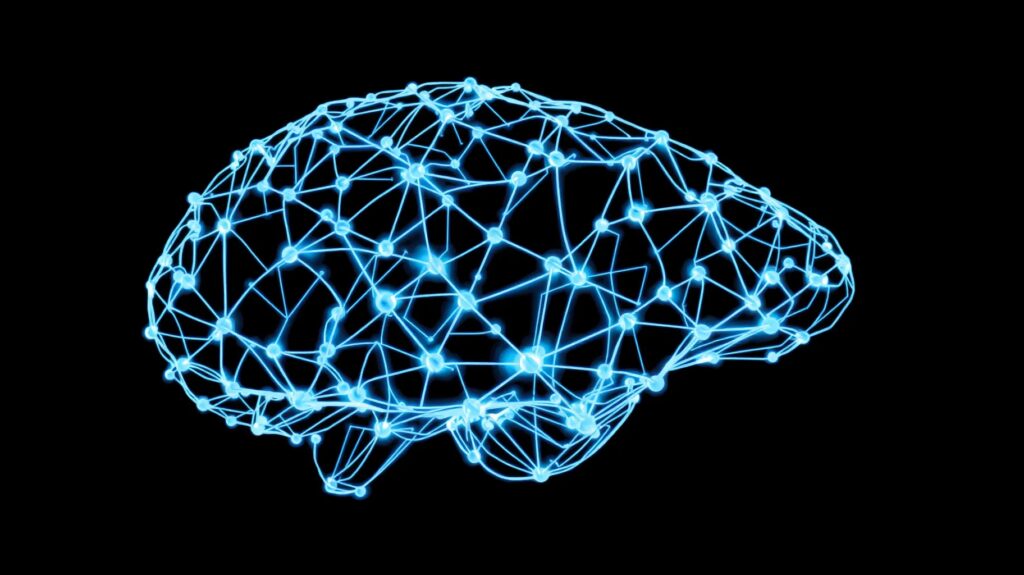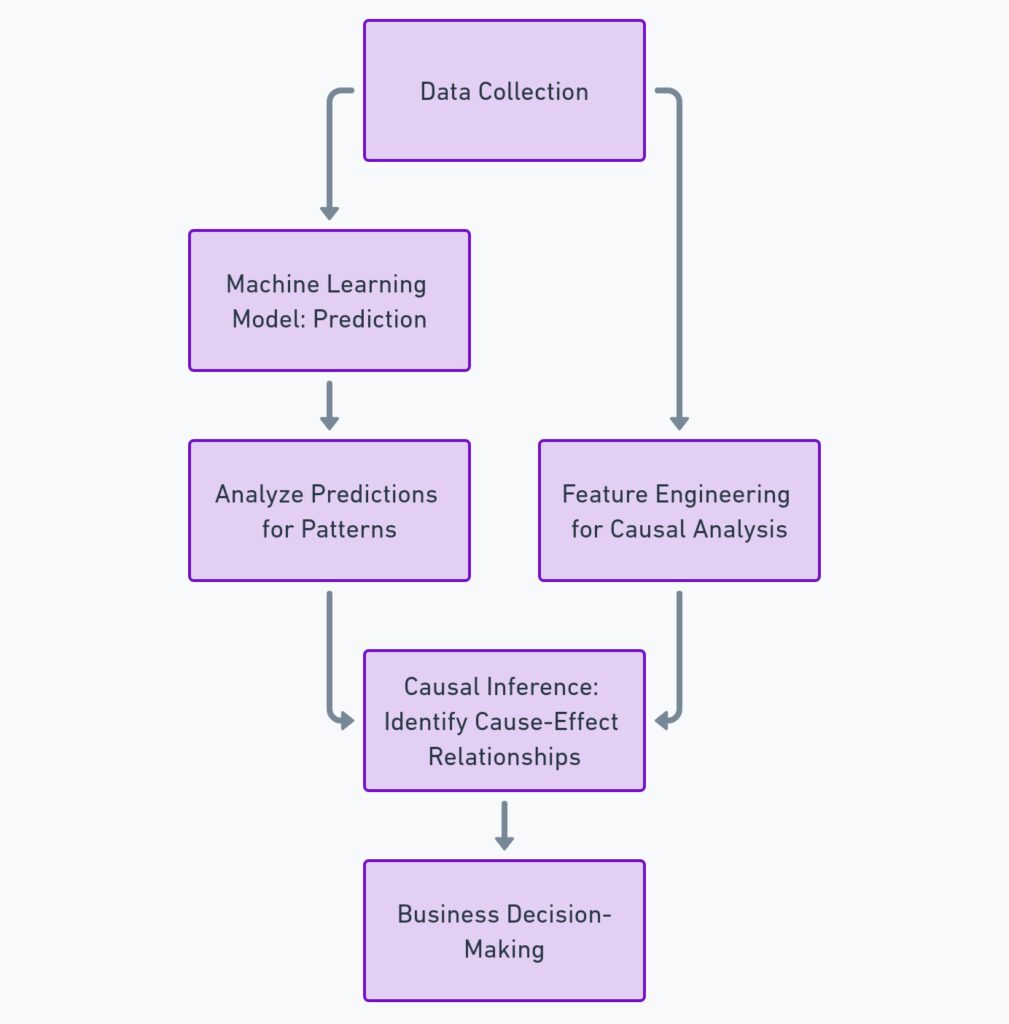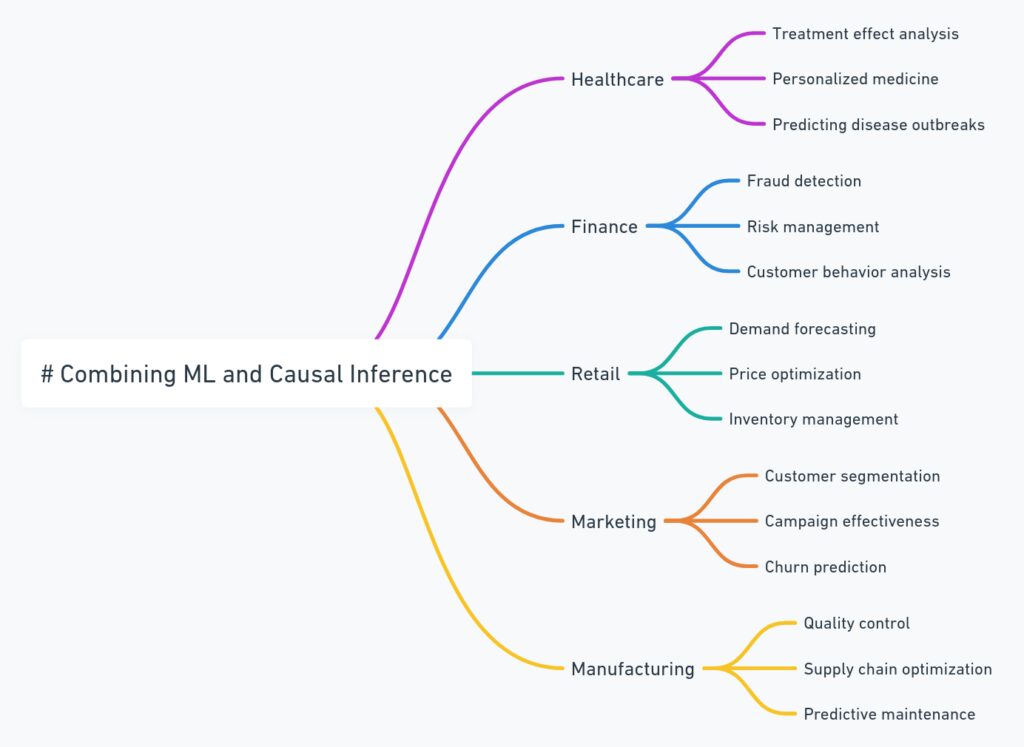
What Makes Causal Inference So Powerful?
Causal inference, at its core, is about determining the “why” behind things. It’s the scientific method that helps us figure out if one thing causes another, rather than just happening alongside it.
Think about it—just because sales go up when the weather is sunny doesn’t mean the sunshine caused the sales boost.
What makes causal inference so powerful is its ability to separate correlation from causation. This distinction matters a lot when making data-driven decisions. For instance, when policymakers design health programs, they need to be sure that the intervention they’re introducing will cause positive outcomes—not just correlate with them.
In simple terms, causal inference helps answer questions like: “Did A actually cause B?” This makes it indispensable in fields like public health, economics, and social sciences.
The Rising Role of Machine Learning in Data Analysis
Machine learning (ML) has taken the world of data by storm. Its predictive capabilities are unrivaled, allowing machines to analyze vast amounts of data and identify patterns that humans could never see.
Whether it’s predicting stock prices, recognizing faces, or even driving cars, ML has transformed countless industries.

The beauty of machine learning lies in its ability to learn from data. It’s not just about programming explicit instructions; rather, it uses algorithms to learn, evolve, and improve its accuracy over time. With the ability to work with large datasets, ML shines in its ability to make accurate predictions from complex, unstructured data.
But while ML is fantastic at prediction, it’s not inherently built to answer the “why” questions that causal inference tackles. This is why combining these two approaches can be such a game changer in analysis.
Why Combine Machine Learning and Causal Inference?
So, why should we even think about combining these two methodologies?
The reason is simple: when used together, machine learning and causal inference bring out the best in each other. Machine learning is great for handling big data, predicting trends, and optimizing results. Causal inference, on the other hand, adds the explanatory power that ML lacks.
For example, machine learning can tell you that customers who buy Product A are more likely to buy Product B. But causal inference can tell you whether promoting Product A will actually lead to more sales of Product B—or if some hidden variable is driving both sales.
By blending these methods, we get robust models that predict outcomes and explain the underlying causes. This is revolutionary for industries like healthcare, where understanding what treatments work and why is as important as knowing which patients will respond.
A New Approach: From Prediction to Explanation
In today’s data-driven world, predictions are only part of the story. Explanation is what drives real-world impact. In fact, most decision-makers need more than just a prediction—they need an understanding of the factors that influence an outcome.
By combining machine learning‘s predictive power with causal inference’s ability to explain, you can not only predict what will happen but also understand why. This is particularly useful in policy-making, where it’s essential to understand the root causes of issues before implementing large-scale solutions.
For example, a predictive model might tell a city government that traffic accidents tend to increase during certain times of the day. But causal inference can dig deeper, helping identify whether the spike is due to increased traffic flow, weather conditions, or even traffic light patterns.
This leads to more informed, effective interventions.
Key Applications in Healthcare and Medicine
The combination of ML and causal inference has made groundbreaking strides in healthcare. In medical research, predicting patient outcomes is crucial, but understanding the causes behind those outcomes is even more critical.
For example, machine learning can predict which patients are at higher risk for certain diseases based on their medical history. But adding causal inference lets doctors pinpoint specific factors that may cause that risk.
This is key for developing personalized treatments. With causal insights, healthcare professionals can determine not just who is at risk but also why, leading to better prevention strategies and targeted therapies. Causal inference could help answer questions like whether a treatment actually works or if patients improve due to external factors, giving way to more effective treatments and healthcare policies.
For example, machine learning might highlight a correlation between a certain drug and patient improvement. But, without causal inference, we can’t be sure if the drug itself caused the improvement—or if other factors were at play.
How Combining ML and CI Impacts Economics
The combination of machine learning and causal inference is transforming economics, too. Economists traditionally rely on causal models to study the effects of policies, investments, or market changes. However, with the rise of big data and more complex datasets, machine learning provides the tools to handle massive amounts of information and uncover intricate patterns.
This hybrid approach is especially valuable in areas like labor economics or market predictions. Machine learning can process years of employment data and forecast trends, but causal inference ensures we understand the forces driving these changes.
For instance, machine learning might show that raising the minimum wage correlates with decreased employment. But causal inference can help clarify if the wage increase actually caused job losses—or if other factors like automation were involved.
Economics, with its focus on policy impacts, stands to gain the most from this blended method. Now, economists can provide not just predictive insights, but also actionable policy recommendations grounded in causal evidence.
Bridging the Gap Between Correlation and Causality
At its core, the combination of ML and causal inference bridges the gap between correlation and causality. While machine learning can analyze massive datasets to find patterns and relationships, it’s not enough to rely on these predictions without knowing what’s truly influencing an outcome.
A great example of this in the real world is advertising. Machine learning algorithms can predict which ads will lead to more clicks or conversions, but causal inference takes it a step further by determining whether the ad was responsible for the behavior, or if other factors played a role.
Was it the ad placement? The time of day? Or maybe the customer was already inclined to make a purchase?
By combining the two, you move from simply identifying trends to truly understanding the mechanisms behind those trends. This has huge implications for sectors like marketing, finance, and public policy, where knowing the “why” is just as critical as predicting the “what.”
Overcoming Common Pitfalls in Causal Inference
Causal inference, while powerful, comes with challenges—especially when it’s applied without caution. One of the biggest pitfalls is confusing correlation with causation, which can lead to faulty conclusions. Even with robust methods like randomized control trials (RCTs) or difference-in-differences techniques, there’s still room for error when hidden variables skew the results.

When machine learning enters the mix, it helps tackle one of causal inference’s limitations: handling high-dimensional data. ML excels at detecting patterns in large datasets, filtering out noise, and identifying relevant factors.
This allows researchers to create cleaner models for causal analysis. But, it’s not a silver bullet.
To overcome these pitfalls, it’s critical to ensure that your machine learning models are designed to minimize bias and correctly adjust for confounding variables. This requires a solid understanding of both statistical principles and algorithmic limitations, so the results are meaningful and actionable.
Machine Learning Techniques That Complement Causal Inference
Some machine learning techniques are especially useful when paired with causal inference. For example, random forests and neural networks can identify complex interactions within data, making it easier to find potential causal relationships.
These algorithms can help sift through massive amounts of information, flagging variables that might be relevant for causal investigation.
Another promising method is causal forests, which combine random forests with causal inference techniques. These models are designed to estimate the heterogeneous treatment effects—essentially, they help pinpoint not just whether something has a causal effect, but how strong that effect is across different groups.
Similarly, counterfactual prediction, which is a staple of causal analysis, pairs well with machine learning models that generate alternative scenarios based on real data. This is particularly useful in evaluating the potential outcomes of policy changes, as it provides a way to measure what would have happened if a different decision had been made.
Real-World Examples of Combined Approaches
The integration of machine learning and causal inference is already yielding real-world results in multiple industries. In healthcare, we see its use in precision medicine, where machine learning models predict patient risk, and causal inference validates which treatments work best. In this way, doctors can tailor interventions, improving patient outcomes.
In education, combined approaches are helping policymakers identify which teaching methods lead to better student performance. While machine learning identifies patterns in student test scores, causal models validate whether changes in teaching strategies caused those improvements or if other factors, like socioeconomic status, played a role.
Finance is another field where these techniques are being applied. Hedge funds use machine learning for market prediction, but causal inference is used to understand whether specific policy changes or economic shocks caused market shifts, which helps fine-tune investment strategies.
In each of these cases, combining prediction and explanation leads to deeper insights that guide better decision-making, demonstrating the power of this hybrid approach.
Challenges and Limitations to Watch Out For
Although combining machine learning with causal inference offers tremendous potential, it’s not without challenges. One major hurdle is the difficulty of correctly specifying the causal model.
Unlike machine learning, where the primary goal is prediction, causal inference demands careful attention to model design and assumptions. If your assumptions are wrong, the entire causal analysis could collapse, leading to inaccurate conclusions.
Additionally, high-dimensional data—while a strength for ML—can overwhelm traditional causal inference methods. Large datasets often contain confounding variables that need to be carefully controlled for, which can be difficult if there are too many variables interacting in complex ways. Mismanaging these variables can skew results, making it difficult to distinguish true causal effects from noise.
Moreover, there’s the risk of overfitting when machine learning models are too finely tuned to the data. This happens when a model becomes overly complex, making it fit the noise in the data rather than identifying the underlying causal relationships. Generalizability becomes a concern, as models that overfit may not perform well when applied to new data.
Lastly, data availability is often an issue. For causal inference to work, you need the right kind of data, including time-series or experimental data that tracks cause and effect over time. Without this, even the most sophisticated ML algorithms can’t establish causality.
The Future of AI: Enhanced Decision-Making with Causal Understanding
The future of artificial intelligence (AI) lies in moving beyond mere predictions toward systems that can make better decisions through an understanding of cause and effect. This shift from “What will happen?” to “Why will it happen?” is critical for creating AI systems that can not only anticipate future outcomes but also recommend actions with confidence.

By integrating causal inference, AI becomes more interpretable and actionable. Imagine a healthcare AI that not only predicts which patients are at risk for heart disease but also explains that the risk is driven by a combination of diet, genetics, and exercise levels. With this insight, doctors can target specific risk factors, rather than simply reacting to high-risk predictions.
As AI systems continue to evolve, decision-making algorithms that incorporate causal understanding will have a greater impact across industries. These systems could drive personalized medicine, develop adaptive economic policies, and create ethical AI models that avoid bias by considering the real causes behind data trends.
Tools and Frameworks Driving Innovation
The rise of combining machine learning with causal inference has led to the development of several cutting-edge tools and frameworks. One of the most popular is DoWhy, an open-source Python library that helps users implement causal inference techniques in data analysis.
DoWhy allows users to estimate causal effects, perform refutation tests, and build robust causal models—bringing ML and CI together in a seamless package.
Another key tool is EconML, developed by Microsoft Research. This tool is particularly useful for economists, as it provides a framework for estimating heterogeneous treatment effects in economic models. By leveraging machine learning alongside causal inference, EconML allows users to assess not only the average treatment effect but also how effects vary across different subgroups.
Meanwhile, companies like Google and Uber are investing heavily in creating internal tools that fuse ML and CI to optimize their operations. These tools allow businesses to go beyond predicting customer behavior and instead understand the causal mechanisms that drive it.
Whether it’s an open-source tool or proprietary system, the innovation happening in this space is opening up new opportunities for businesses, researchers, and policymakers alike.
Ethical Considerations in ML and Causal Inference Research
As powerful as machine learning and causal inference can be when combined, they also raise important ethical questions. In particular, concerns around data privacy, bias, and the fairness of causal models need to be addressed. Since ML often uses personal data to train its models, it’s crucial to ensure that data is handled responsibly and ethically.
Moreover, machine learning algorithms can sometimes reinforce existing biases. For example, if historical data reflects societal biases (e.g., in hiring practices or loan approvals), machine learning could inadvertently perpetuate those biases. This is where causal inference becomes invaluable.
By understanding the root causes behind data patterns, researchers can identify and correct for these biases, ensuring more equitable outcomes.
However, even with the best tools and intentions, causal analysis requires transparency. Researchers need to clearly communicate their assumptions and methodologies, so that findings can be scrutinized and improved upon. In many cases, it’s not enough to know that something works—you need to ensure that it works fairly.
How Businesses Can Benefit from This Combination
Businesses across various industries can reap significant rewards by combining machine learning and causal inference. In marketing, companies can move beyond simply identifying which campaigns drive the most engagement to understanding why certain messages resonate better with specific demographics.
This knowledge allows marketers to create more effective, personalized campaigns, leading to higher ROI and better customer satisfaction.

In finance, combining these approaches helps firms not only predict market movements but also understand the causes behind those trends. For example, if a machine learning model predicts a rise in stock prices, causal inference can investigate whether the increase is due to market sentiment, economic policies, or corporate earnings reports.
This deeper understanding allows businesses to make more informed investment decisions.
Even in manufacturing, businesses can use causal inference to optimize operations. A machine learning model might predict that downtime will increase next quarter, but causal inference can explain if that’s due to aging equipment, supply chain disruptions, or human error. By addressing the root cause, companies can preempt problems and improve efficiency.
Ultimately, businesses that harness both predictive and causal insights will be better positioned to make smarter, more informed decisions that drive long-term success.
Final Thoughts: The Future of Data-Driven Decisions
The fusion of machine learning and causal inference is shaping the future of data-driven decision-making. As businesses, researchers, and policymakers continue to embrace this hybrid approach, they can move beyond simply predicting trends to understanding the forces that drive those trends.
By combining the predictive power of machine learning with the explanatory depth of causal inference, organizations gain the ability to not only forecast future outcomes but also make decisions rooted in clear, actionable insights. This combination allows industries to avoid reactive strategies, instead proactively addressing the root causes behind their challenges.
Whether it’s optimizing healthcare, improving economic policy, or creating more ethical AI, the integration of these two fields offers a new frontier in understanding and shaping the world around us. Those who embrace this methodology now are likely to lead the charge into a smarter, more informed future.
FAQs: Combining Machine Learning and Causal Inference
Why is combining machine learning and causal inference important?
Machine learning excels at making predictions from large datasets, but it doesn’t inherently provide explanations for why certain patterns emerge. Causal inference fills this gap by explaining the relationships between variables, allowing for more informed and actionable decision-making. Together, they offer both predictive power and deep insights into causal mechanisms.
In which industries is the combination of ML and causal inference most useful?
This combination is highly valuable in healthcare, where it’s used for personalized treatments and understanding what causes patient outcomes. It’s also transformative in economics, marketing, finance, and public policy, where understanding both predictions and causal factors can lead to more effective strategies and interventions.
Can machine learning on its own determine causality?
No, machine learning is designed primarily for prediction and pattern recognition, not for establishing causality. While it can identify relationships between variables, it doesn’t explain whether one variable causes another. This is why causal inference is needed to interpret the cause-and-effect relationships within data.
What are some common challenges when combining ML and causal inference?
Some challenges include handling high-dimensional data, avoiding overfitting in machine learning models, and ensuring that the causal models are correctly specified. Additionally, confounding variables, which may skew results, must be carefully controlled, and data availability is often a limitation when trying to apply causal methods.
What tools are available to help combine ML and causal inference?
There are several open-source tools, such as DoWhy, which simplifies causal inference tasks, and EconML, designed to estimate treatment effects in economic models. These tools allow users to implement causal techniques alongside machine learning, enabling deeper insights and more robust analyses.
How does combining these approaches benefit businesses?
Businesses can make better decisions by understanding the why behind trends, not just the what. For example, in marketing, they can discover why certain ads lead to conversions, and in finance, they can understand why specific factors drive market changes. This deeper insight leads to more effective strategies, higher ROI, and better long-term outcomes.
How does causal inference help avoid bias in machine learning models?
Causal inference helps identify and adjust for confounding variables, which can introduce bias in machine learning predictions. By understanding the true causes of outcomes, businesses can create more fair and equitable models, reducing the risk of reinforcing historical biases in data.
Are there any ethical concerns with combining ML and causal inference?
Yes, there are ethical concerns, particularly around data privacy and bias. As these approaches rely on large datasets, protecting sensitive information is crucial. Additionally, if data used for machine learning reflects societal biases, causal inference can help identify and address these biases, but it requires transparency and careful handling to avoid unfair outcomes.
What is the future of combining ML and causal inference?
The future is bright for this combination, as it will lead to more intelligent, decision-making AI systems that not only predict outcomes but also understand the underlying causes. This will enhance fields like personalized medicine, economic policymaking, and ethical AI development, driving better results across industries.
How does machine learning improve causal inference?
Machine learning enhances causal inference by automating the process of identifying complex patterns in large datasets. It helps handle high-dimensional data, where there are many variables to consider, and can detect non-linear relationships that traditional methods might miss. ML can also pre-process data by selecting the most relevant variables, reducing noise and improving the accuracy of causal models.
What is a confounding variable, and why is it important in causal inference?
A confounding variable is an external factor that influences both the independent and dependent variables, creating a false impression of a causal relationship between them. For example, ice cream sales and drowning incidents are correlated, but the confounding variable is hot weather. In causal inference, identifying and controlling for confounders is essential to avoid misleading results.
How does causal inference ensure that machine learning models are interpretable?
Machine learning models, especially deep learning models, are often considered “black boxes” because their inner workings are hard to interpret. By incorporating causal inference, researchers can identify which variables have a true causal impact, making the model more interpretable. This helps decision-makers understand the reasoning behind predictions, increasing trust and accountability in ML systems.
What are some real-world examples of causal inference in action?
In medicine, causal inference is used to determine whether a treatment causes an improvement in patient health, rather than just being correlated with recovery. In marketing, it helps companies figure out whether an advertising campaign actually drives sales, or if other factors are responsible. In public policy, causal inference is used to assess the impact of policies, such as determining whether education reforms lead to better student outcomes.
What is the difference between observational data and experimental data in causal inference?
Experimental data comes from controlled experiments, where researchers manipulate one variable to observe its effect on another, minimizing confounding factors. Observational data, on the other hand, is collected without manipulation—researchers observe natural events as they occur. In causal inference, both types of data are used, but observational data requires more sophisticated techniques to account for confounding variables and biases.
Can causal inference be used in real-time decision-making?
Yes, real-time decision-making is possible by integrating causal inference into machine learning systems. For instance, in dynamic environments like online advertising or e-commerce, businesses can run experiments and use causal inference to quickly determine which factors influence consumer behavior. This allows for real-time optimizations and more effective decision-making, improving customer engagement and sales.
How does counterfactual analysis relate to causal inference?
Counterfactual analysis asks the question, “What would have happened if a different action had been taken?” It’s a key component of causal inference, used to estimate the outcome of a scenario that didn’t actually occur. In machine learning, counterfactuals can be used to evaluate the effect of different decisions, like simulating what would happen if a marketing campaign hadn’t been run. This helps businesses and policymakers make more informed choices by considering all possible outcomes.

What role does causal inference play in A/B testing?
A/B testing is a method used to compare two versions of something—like a webpage or a product feature—to see which one performs better. Causal inference ensures that the differences in outcomes are due to the tested factor, not random chance or confounding variables. By applying causal models, businesses can trust that their A/B test results are accurate and actionable.
What is a causal model, and how does it work with machine learning?
A causal model is a framework used to represent and understand the cause-and-effect relationships between variables. It defines the mechanisms through which one variable influences another. When combined with machine learning, causal models help improve the interpretability of predictions by identifying which variables truly cause changes in outcomes, rather than just associating patterns.
How can businesses leverage machine learning and causal inference for growth?
Businesses can use machine learning to predict customer behavior and trends while applying causal inference to understand what actions lead to desired outcomes. For example, an online retailer might use ML to predict which products will sell well and then apply causal inference to discover which marketing tactics directly cause higher sales. This combination leads to smarter, data-driven strategies that fuel business growth.

Are there any specific industries that stand to benefit most from this combination?
While many industries can benefit, healthcare, economics, finance, and marketing stand out. In healthcare, combining ML and causal inference can improve diagnostics and personalized treatment plans. In economics, it helps policymakers evaluate the effectiveness of interventions. Finance professionals can use this approach for risk management and investment strategies, while marketing teams can understand consumer behavior at a deeper level to drive engagement and conversion.

How does causal inference improve the fairness of machine learning algorithms?
By identifying the true causes of outcomes, causal inference helps to mitigate bias in machine learning algorithms. It allows researchers to pinpoint and correct for unfair advantages or disadvantages within the data, ensuring that predictions are not skewed by confounding variables related to sensitive attributes like race, gender, or socioeconomic status. This leads to more ethical AI systems that make fairer, more just decisions.
What are the limitations of causal inference in machine learning?
While causal inference adds great value to machine learning, it’s not without limitations. One key challenge is the difficulty of accurately modeling complex causal relationships in high-dimensional data. Additionally, finding the right data for causal inference can be difficult, as it often requires experimental or longitudinal data that isn’t always available. Moreover, incorrect assumptions in causal models can lead to flawed conclusions.
Software & Tools:
- DoWhy (Python)
DoWhy is an open-source Python package that helps with causal inference and integrates smoothly with machine learning models. It offers intuitive tools to estimate causal effects, test models, and verify assumptions.
GitHub link - EconML (Python)
Developed by Microsoft Research, EconML is a Python package for estimating treatment effects with machine learning models. It’s especially useful in economics and policy evaluation.
GitHub link - Tetrad
This software, developed by Carnegie Mellon University, offers causal discovery and statistical tools. It’s ideal for both novices and advanced users exploring causal inference models.
Research Papers and Articles:
- “A Unified Approach to Causal Inference in Machine Learning” by David Sontag
This paper presents techniques to unify machine learning and causal inference, explaining how combining them can lead to better, more actionable insights in fields like healthcare.
PDF link - “Causal Impact” by Kay H. Brodersen et al.
This article discusses Google’s Causal Impact tool, which estimates the effect of an intervention using Bayesian structural time-series models. It’s especially useful for A/B testing in marketing. - “The Seven Tools of Causal Inference with Reflections on Machine Learning” by Judea Pearl
A seminal paper that discusses the vital tools of causal inference and how machine learning can incorporate them. Pearl discusses key advancements in both fields and how they converge.
Communities & Forums:
- Stack Exchange – Cross Validated
A Q&A community for statistics, machine learning, and causal inference questions. You can find expert advice and real-world examples here.
Community link - r/CausalInference (Reddit)
A subreddit dedicated to discussing causal inference, with insights and discussions from academics and industry professionals alike.
Subreddit link - Towards Data Science (Medium)
A popular publication on Medium, where professionals share articles on machine learning, causal inference, and data science in general. It’s a great place for tutorials, research, and case studies.
Website link